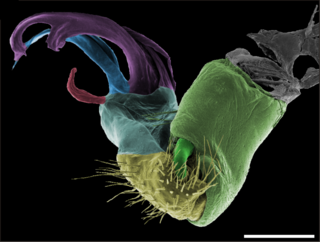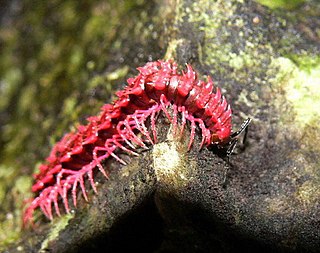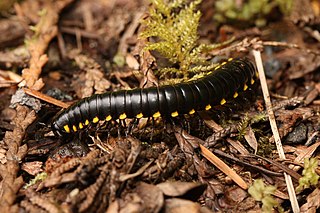
Millipedes are a group of arthropods that are characterised by having two pairs of jointed legs on most body segments; they are known scientifically as the class Diplopoda, the name derived from this feature. Each double-legged segment is a result of two single segments fused together. Most millipedes have very elongated cylindrical or flattened bodies with more than 20 segments, while pill millipedes are shorter and can roll into a tight ball. Although the name "millipede" derives from Latin for "thousand feet", no species was known to have 1,000 or more until the discovery in 2020 of Eumillipes persephone, which can have over 1,300 legs. There are approximately 12,000 named species classified into 16 orders and around 140 families, making Diplopoda the largest class of myriapods, an arthropod group which also includes centipedes and other multi-legged creatures.

Gonopods are specialized appendages of various arthropods used in reproduction or egg-laying. In males, they facilitate the transfer of sperm from male to female during mating, and thus are a type of intromittent organ. In crustaceans and millipedes, gonopods are modified walking or swimming legs. Gonopods may be highly decorated with elaborate structures which may play roles in sperm competition, and can be used to differentiate and identify closely related species. Gonopods generally occur in one or more pairs, as opposed to the single (un-paired) reproductive organs such as the aedeagus of insects or the penis of harvestmen.

Desmoxytes, whose species are commonly known as the dragon millipedes, is a genus of millipedes of the family Paradoxosomatidae found in Southeast Asia. The genus was described by Ralph Vary Chamberlin in 1923, and reviewed by Sergei Golovatch and Henrik Enghoff in 1994. At least 18 species are known from to Malaysia, Myanmar, and Thailand. One species, D. planata, has also been observed in Sri Lanka, the Andaman Islands, Seychelles, Java, Great Coco Island, and Fiji; however, this species has expanded its range by being transported through human activity. Several species have only recently been discovered, and some have yet to be officially described.

Polydesmida is the largest order of millipedes, containing approximately 3,500 species, including all the millipedes reported to produce hydrogen cyanide (HCN). Polydesmids grow and develop through a series of moults, adding segments until they reach a fixed number in the adult stage, which is usually the same for a given sex in a given species, at which point the moulting and the addition of segments and legs stop. This mode of development, known as teloanamorphosis, distinguishes this order from most other orders of millipedes, which usually continue to moult as adults, developing through either euanamorphosis or hemianamorphosis.

Xystodesmidae is a family of millipedes. Its members often have very small distributional areas, with many species only known from a single locality. They are found across the northern hemisphere, with peak diversity in the Appalachian Mountains, where one-third of the 300 or so species occur. They are particularly abundant in deciduous broadleaf forests in the Mediterranean Basin, Africa, Asia, Central and North America, and Russia. Information on basic taxonomy is scant for this family; for example, it is estimated that the genus Nannaria contains over 200 species, but only 25 were described as of 2006. By 2022, 78 species in Nannaria have been described.
Tridontomidae is a small family of millipedes. Its members are endemic to Guatemala. These millipedes range from 22 mm to 28 mm in length and are uniformly grayish in color; their legs and antennae are unusually long and slender. This family includes the remarkable species Aenigmopus alatus, in which adult males feature no gonopods. This millipede is the only species in the infraclass Helminthomorpha without gonopods.

Motyxia is a genus of cyanide-producing millipedes that are endemic to the southern Sierra Nevada, Tehachapi, and Santa Monica mountain ranges of California. Motyxias are blind and produce the poison cyanide, like all members of the Polydesmida. All species have the ability to glow brightly: some of the few known instances of bioluminescence in millipedes.

Harpaphe is a genus of flat-backed millipedes native to the Pacific Northwest of North America. The genus contains three described species: two occurring only in northern California, and one with a large range extending from Southeast Alaska to Central California.

Chordeumatida is a large order of millipedes containing some 1200 species with a nearly worldwide distribution. Also known as sausage millipedes, they grow and develop through a series of moults, adding segments until they reach a fixed number in the adult stage, which is usually the same for a given sex in a given species, at which point the moulting and the addition of segments and legs stop. This mode of development, known as teloanamorphosis, distinguishes this order from most other orders of millipedes, which usually continue to moult as adults, developing through either euanamorphosis or hemianamorphosis.

Orthomorpha coarctata, the long-flange millipede, is a widely introduced species of Polydesmidan millipede of the family Paradoxosomatidae. It is presumed native to Southeast Asia but due to transport by humans occurs in tropical and sub-tropical areas throughout the world, including the Hawaiian Islands, the West Indies, Gulf Coast of North America, and the Galápagos Islands.
Brachoria is a genus of polydesmidan millipedes in the family Xystodesmidae inhabiting the Eastern United States. Also known as the Appalachian mimic millipedes, at least 30 species are known, with highest diversity in the Appalachian Mountains, especially the Cumberland Plateau and Ridge and Valley Province.

Platyrhacidae is a family of polydesmidan millipedes distributed in Southeast Asia and tropical Central and South America.

Xystocheir is a genus of millipedes in the family Xystodesmidae. The genus is endemic to California in the United States, where it is distributed in the Coast Ranges and the Sierra Nevada.

Apheloria tigana, known as the yellow-and-black flat millipede, is a large North American flat-backed millipede in the family Xystodesmidae. It is reported to secrete cyanide compounds as a defense. It is recommended that one wash hands after handling this organism as the toxic compounds it secretes are poisonous and can cause extreme irritation if rubbed in the eyes.

Apheloria is a genus of flat-backed millipedes in the family Xystodesmidae, occurring in the central and southeastern United States, and ranging as far north as southern Quebec, Canada. They are aposematically colored in black and contrasting reds and yellows, and some species in the Appalachian Mountains resemble species of Brachoria where they co-occur, a phenomenon known as Müllerian mimicry.
Brachoria dentata, the Pennington Gap mimic millipede, is an Appalachian mimic millipede in the Xystodesmidae family.

Pleuroloma flavipes, commonly known as the traveling cherry millipede, is a species of flat-backed millipede in the family Xystodesmidae. It has the widest distribution of any species of xystodesmid millipede and is found in eastern North America from southeastern North Dakota, eastward to Connecticut, and southward to North Carolina, northern Louisiana, and southern Texas. Pleuroloma flavipes millipedes are occasionally observed in large aggregations of individuals where they appear to move en masse in a certain direction, hence the common name "wandering cherry millipede". In a report from 1950, an aggregation of about 6,000 individuals were encountered on a single bridge at McCormick's Creek State Park, Indiana. The species is extremely variable in coloration, and converges in appearance with several species of Apheloria and Brachoria as a result of mimicry.

Nearctodesmidae is a family of flat-backed millipedes in the order Polydesmida. There are about 7 genera and 17 described species in Nearctodesmidae.

Cherokia Chamberlin, 1949 is a genus consisting of a single species, Cherokia georgiana. Commonly known as the wrinkled flat-backed millipede, this species belongs to the order Polydesmida and the family Xystodesmidae. It inhabits forests in the southeastern United States, particularly those with hemlock, maple, tulip poplar, rhododendron, cedar, and spruce-fir trees.

Stenoniodes, commonly known as the Borneo tractor millipede, is a genus of millipede in the family Platyrhacidae. It contains six species, five of which occur on Borneo and one on Sibutu Island. Its common name originates from the likeness of its 20-segmented body to the tread of a tractor's tire.


















